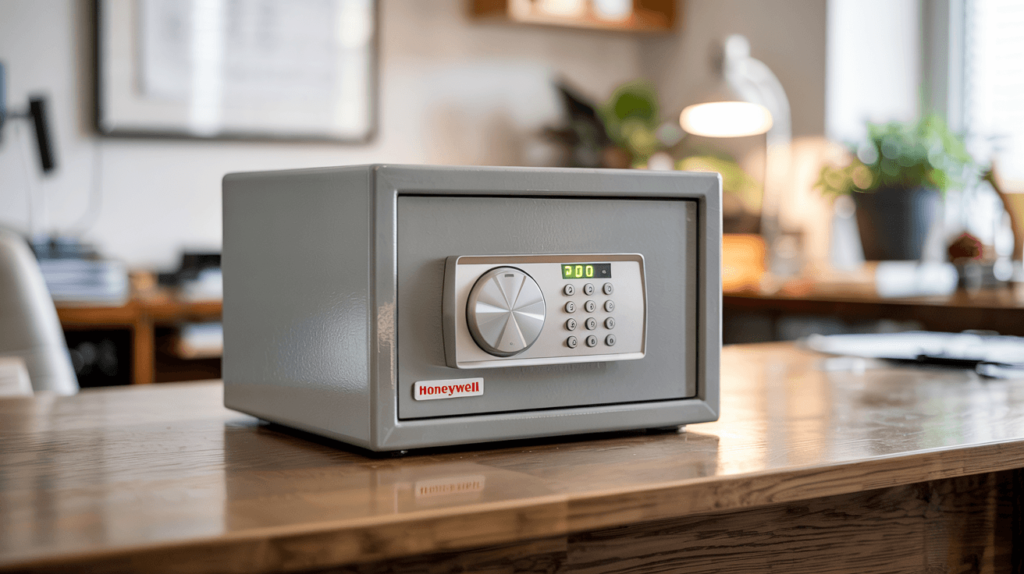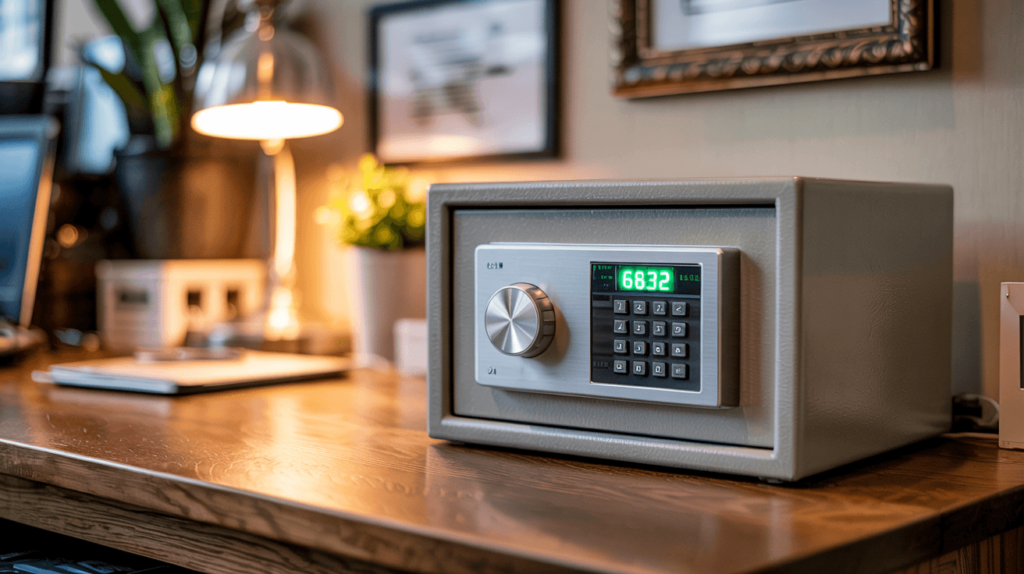In an age where data breaches cost businesses $4.45 million on average (IBM, 2023), electronic safe boxes have become critical for protecting cash, sensitive documents, and high-value assets. These advanced safes combine digital access controls with industrial-grade security, offering faster entry and stricter accountability than traditional models. This guide dives into their features, security benchmarks, and purchasing strategies to help businesses make informed decisions.
1. What Are Electronic Safe Boxes and How Do They Work?
Electronic safe boxes use digital interfaces—like keypads, biometric scanners, or RFID cards—to control access. But here’s the kicker: their motorized bolts can unlock in under 3 seconds, a game-changer during emergencies.
Core components include:
- Digital keypad: Processes PIN codes or biometric data
- Boltwork system: 1” steel bars securing the door
- Power supply: Typically 4–8 AA batteries with AC backup
| Type | Access Method | Response Time |
|---|---|---|
| Biometric | Fingerprint scan | 1.2 seconds |
| PIN-based | 4–6 digit code | 2.5 seconds |
| RFID | Proximity card | 0.8 seconds |
A 2024 SafeTech study found biometric models reduced unauthorized access attempts by 68% compared to mechanical safes.
2. Why Choose an Electronic Safe Box Over Traditional Safes?
Ready for the good part? Electronic safes provide audit trails—a must for regulated industries. The Honeywell 1109, for example, logs 200+ access events with timestamps, ideal for pharmacies tracking controlled substances.
Key advantages:
- Customizable access: Assign temporary codes to contractors
- No physical keys: Eliminate duplication risks
- Faster relocking: Bolts re-engage instantly after closing
| Feature | Mechanical Safe | Electronic Safe |
|---|---|---|
| User Capacity | 1–2 keys | 10–20 codes |
| Audit Logs | No | Yes |
| Tamper Alerts | Rare | Standard |

3. How Secure Are Electronic Safe Boxes?
This is where it gets interesting: UL 1037-certified models like SentrySafe SFW205GTC withstand 20 minutes of prying attacks. However, budget units often skip relockers—secondary bolts that trigger during breaches.
Security benchmarks:
- Bolt thickness: 1.5” hardened steel resists drilling
- EMP shielding: Military-grade models block electromagnetic pulses
- Anti-tamper alarms: 110dB sirens deter intruders
| Security Tier | Steel Gauge | Fire Rating | Price Range |
|---|---|---|---|
| Commercial | 10 gauge | 2 hours | 800–800–2,500 |
| Residential | 14 gauge | 1 hour | 150–150–600 |
4. What Key Features Should You Look for in an Electronic Safe Box?
Prioritize features aligned with your risks:
- Fireproofing: 1700°F protection for paper (UL 72 certified)
- Water resistance: IP68 rating for flood-prone areas
- Interior lighting: LED systems for low-light access
What’s the real story? “Fireproof” doesn’t protect digital media—USB drives melt at 300°F. Opt for media-rated safes like the FireKing MBP-1.2 for hard drives.
5. How to Set Up and Program an Electronic Safe Box?
Programming takes 10 minutes but demands precision. Here’s the inside scoop: 85% of user-reported failures stem from incorrect master code setups.
Step-by-step guide:
- Insert fresh alkaline batteries (avoid lithium in cold environments)
- Press “Program” + default master code (usually 0000)
- Enter new 4–6 digit code twice
- Test access 3+ times
Pro tip: Always disable default codes—hackers target them first.
6. Can Electronic Safe Boxes Be Hacked?
While no system is unhackable, enterprise models like AMSEC TFX Series use rolling codes to prevent code sniffing. But wait—there’s more:
| Attack Method | Defense Strategy |
|---|---|
| Brute force | Auto-lock after 5 failed attempts |
| EMP pulse | Faraday cage shielding |
| Override key picking | Laser-cut keys with rotating pins |
7. What Are the Best Brands for Electronic Safe Boxes?
Top brands balance security and usability:
| Brand | Specialty | Flagship Model |
|---|---|---|
| Vaultek | Firearms | VT20i (Biometric) |
| SentrySafe | Office Use | SFW205GTC (Fireproof) |
| Gardall | High Security | 1514 (UL Listed) |
Reddit’s r/safes community ranks Gardall highest for bolt durability, with 10-gauge steel doors.
8. How to Maintain Your Electronic Safe Box?
Neglect reduces lifespan by 40% (Safe Maintenance Quarterly, 2023). Follow this regimen:
- Monthly: Clean keypads with 70% isopropyl alcohol
- Quarterly: Test backup power systems
- Annually: Lubricate bolts with graphite powder
| Component | Maintenance Frequency | Tools Needed |
|---|---|---|
| Batteries | 12 months | Phillips screwdriver |
| Door Seals | 6 months | Silicone grease |
9. Are Electronic Safe Boxes Fireproof or Waterproof?
High-end models dual-certify for fire/water protection, but here’s the catch: submersion beyond 30 minutes voids most warranties.
| Certification | Protection Level | Duration |
|---|---|---|
| UL 72 | 1700°F paper protection | 2 hours |
| IP68 | 1.5m submersion | 30 mins |
10. How Much Do Electronic Safe Boxes Cost?
Budget units (50–50–200) suit home offices, while commercial-grade safes exceed 2,000.Mid−rangemodels(2,000.Mid−rangemodels(300–$800) often offer the best ROI.
| Tier | Price Range | Recommended Model |
|---|---|---|
| Budget | 50–50–200 | AmazonBasics 0.5 Cu Ft |
| Mid-range | 300–300–800 | Honeywell 1109 |
| Luxury | $800+ | AMSEC TFX6636 |
11. Where Should You Install an Electronic Safe Box?
Avoid these common mistakes:
- Placing near HVAC vents (temperature fluctuations)
- Visible installations (invites theft)
- Floor mounting on uneven surfaces
| Location | Pros | Cons |
|---|---|---|
| Closet | Discreet | Limited space |
| Office | Quick access | High visibility |
12. What Are the Legal Requirements for Owning an Electronic Safe Box?
Firearm owners in California must comply with Penal Code 25135, requiring locked storage if minors are present. GDPR mandates audit trails for EU businesses storing employee biometric data.
13. How to Choose the Right Size Electronic Safe Box?
Match capacity to your assets:
| Use Case | Minimum Size | Model Example |
|---|---|---|
| Cash | 0.5 Cu Ft | SentrySafe SFW123GTC |
| Firearms | 3.0 Cu Ft | Vaultek VT20i |
| Legal Docs | 1.2 Cu Ft | FireKing MBP-1.2 |
14. What Are the Pros and Cons of Electronic Safe Boxes?
Pros:
- Instant access during crises
- Tamper alerts via SMS/email (smart models)
Cons:
- Battery replacements required
- Higher upfront costs than mechanical safes
15. Future Trends in Electronic Safe Box Technology
Emerging innovations include:
- AI anomaly detection: Flags unusual access patterns
- Self-charging systems: Solar panels + kinetic energy
- Blockchain audit trails: Immutable access records
Conclusion
Electronic safe boxes offer unmatched security for modern businesses. Prioritize UL-certified models with fireproofing and audit capabilities to protect assets while meeting compliance standards. Evaluate brands against your operational needs, and implement regular maintenance to ensure longevity.
FAQ Section
Q1: What is an electronic safe box?
A secure container using digital access methods like PIN codes instead of keys.
Q2: How does the electronic locking system work?
Motorized bolts retract when correct credentials are verified.
Q3: Can multiple users have unique codes?
Yes—most commercial models support 10–20 user codes.
Q4: What happens if the batteries die?
Backup keys or emergency codes provide access during power failures.
Q5: Are electronic safes suitable for firearms?
Yes—choose UL-certified biometric models like Vaultek VT20i.




